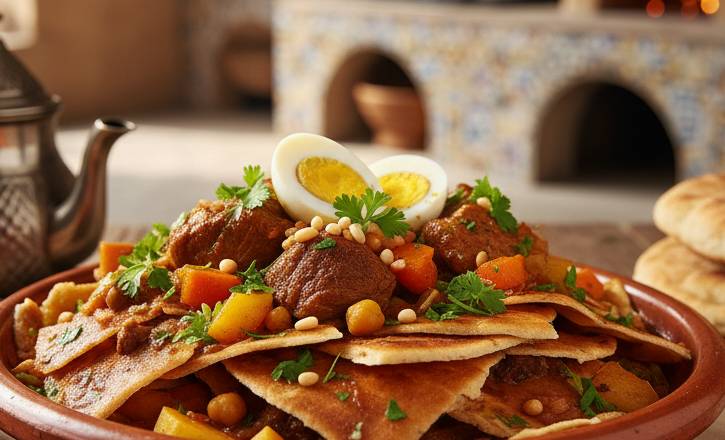
Tharid is a dish steeped in history and tradition, revered across the Arabian Peninsula. Its origins trace back to pre-Islamic times, and it’s famously known as one of the favorite meals of the Prophet Muhammad, peace be upon him. At its core, tharid is a comforting and rustic stew of meat and vegetables, served over a bed of flatbread. To make it authentically is to embrace its simplicity and rich, concentrated flavors. This guide will walk you through the traditional method of preparing this venerable dish.
The Essential Ingredients for Authentic Tharid
- Lamb or Mutton: This is the traditional meat for tharid, providing a rich, fatty broth that is the soul of the dish. Use bone-in pieces for the most flavorful results.
- Root Vegetables: Carrots and potatoes are a must. They cook down to tender, sweet morsels that absorb the stew’s flavor.
- Onions and Garlic: The aromatic foundation of the stew.
- Tomatoes: Fresh or canned, they provide the necessary acidity and a base for the sauce.
- Traditional Spices: The spice profile is simple but crucial: turmeric, black pepper, and coriander. You can also add a touch of cinnamon or cardamom for a richer aroma.
- Flatbread (Khubz or Raqqaq): This is what makes tharid unique. Traditional, thin, unleavened bread is used to soak up the broth, transforming the dish.
Step-by-Step Instructions
- Brown the Meat: In a large pot or Dutch oven, heat a little oil or ghee. Add the bone-in lamb or mutton and brown it on all sides. This step is crucial for building a deep, savory flavor. Once browned, remove the meat from the pot and set it aside.
- Build the Broth Base: In the same pot, add the chopped onions and sauté until they are soft and translucent. Add the minced garlic and cook for another minute until fragrant. Stir in the chopped tomatoes, cooking until they break down and create a thick paste.
- Add the Spices and Meat: Now, add the turmeric, black pepper, and coriander to the pot, stirring for about a minute until the spices are fragrant. Return the browned meat to the pot and stir to coat it in the spice mixture.
- Simmer the Stew: Pour enough water over the meat and vegetables to cover them completely. Bring the mixture to a boil, then reduce the heat to a low simmer. Cover the pot and let the stew cook for at least 1-2 hours, or until the lamb is incredibly tender and falling off the bone. A long, slow simmer is key to a rich and flavorful broth.
- Finish with Vegetables: About 30-40 minutes before serving, add the chopped carrots and potatoes to the pot. They will cook to perfection without becoming mushy. Taste the broth and adjust the salt as needed.
- Assemble and Serve: This is where tharid gets its name. Tear the flatbread into bite-sized pieces and place them in the bottom of a large, deep serving platter. Ladle the hot stew over the bread. The bread will immediately begin to soak up the flavorful broth, becoming soft and tender. The longer you let it sit, the softer the bread becomes, blending perfectly with the stew.
Conclusion
Authentic tharid is more than just a meal; it’s a testament to the power of simple, honest ingredients and patient cooking. It’s a dish that embodies community and hospitality, meant to be shared. By following these steps, you’re not just making a meal—you’re preparing a dish that has nourished people for centuries. Enjoy this delicious, historical recipe.
FAQ
Can I use other types of meat?
While lamb or mutton are traditional, you can make tharid with bone-in beef or chicken. The cooking time will vary, with chicken requiring less time to become tender.
Is tharid a soup or a stew?
Tharid is a hearty stew. The bread at the bottom of the dish soaks up the broth, so it’s not meant to be eaten with a spoon like a soup, but rather with a fork.
Why is the long simmering time so important?
The long, slow cooking process is what makes the meat incredibly tender and allows the flavors of the spices, meat, and vegetables to meld together. This is how you achieve the deep, complex flavor that defines authentic tharid.
Can I make tharid ahead of time?
You can prepare the stew the day before, which can even enhance the flavors. However, do not add the bread until just before serving. The bread must be fresh and crispy when you add the hot stew to ensure it soaks up the liquid properly without becoming a soggy mess.